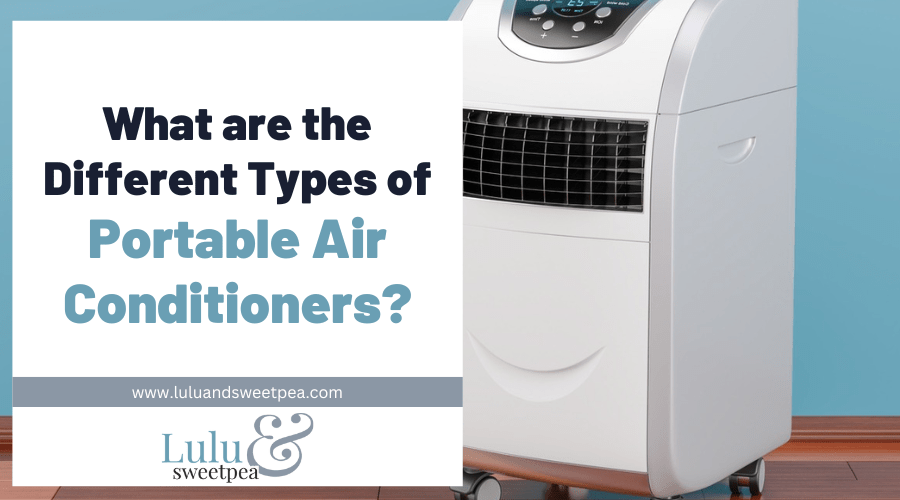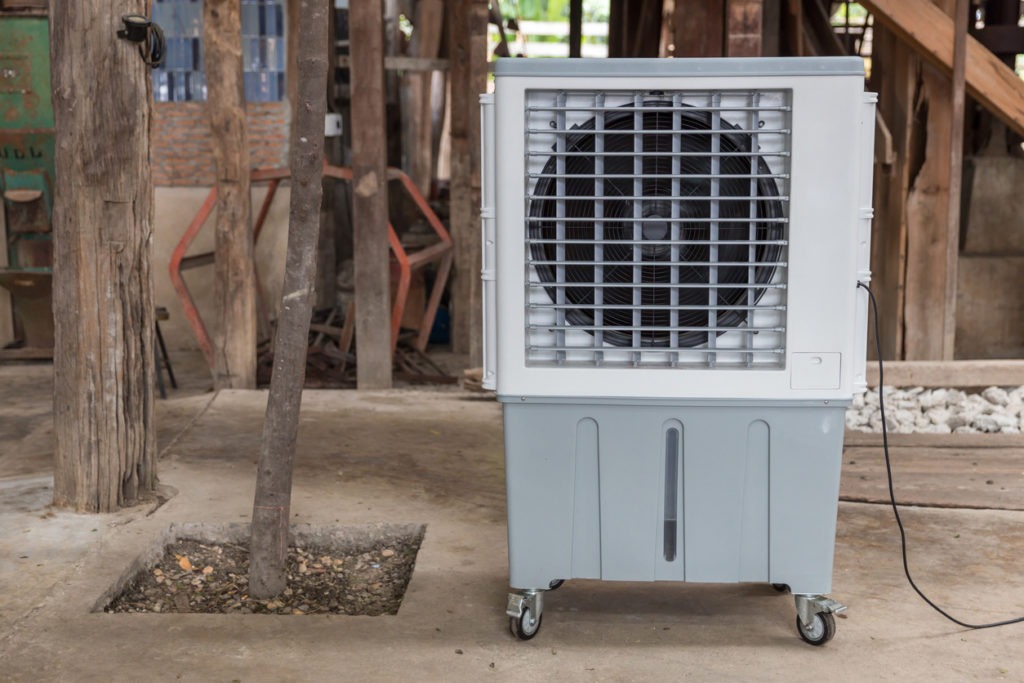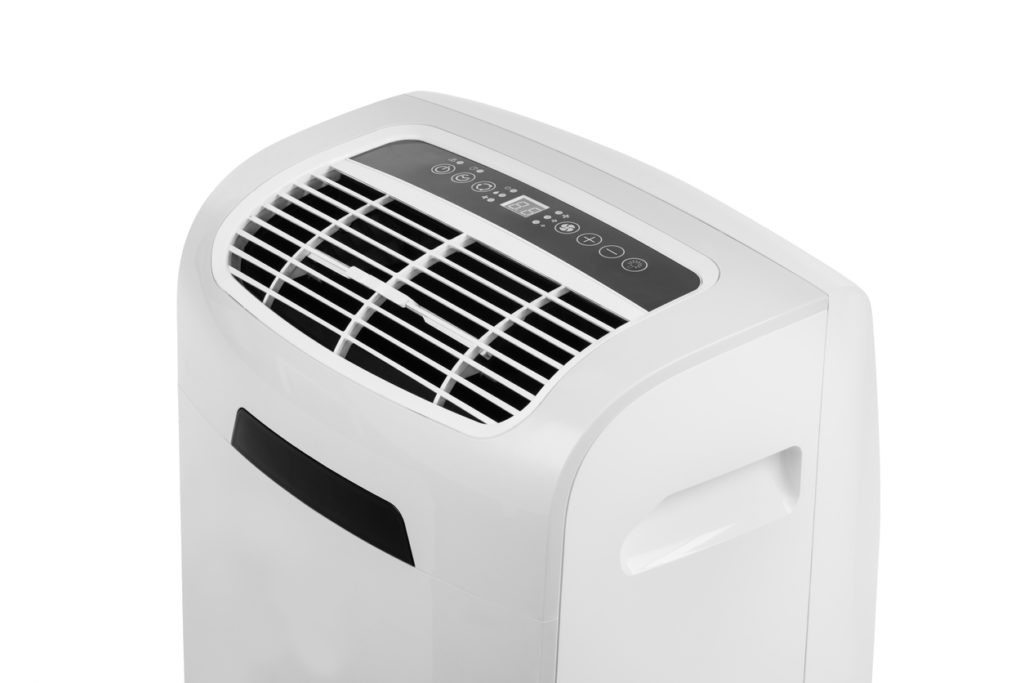Similar to window air conditioners are portable air conditioners. They are likewise contained in a single unit with all of its parts enclosed inside, but this unit is free-standing and can be moved from room to room. All it needs to get started are a power outlet and access to a window where the unit’s air may be evacuated by using its funnel.
If you need temporary space cooling or if it is not feasible to install a window or split air conditioner, you can choose a portable air conditioner. They come in many useful sizes, and the smallest ones can even be utilized in kennels or restrooms. Air from within a room is drawn in by a single hose in a portable AC unit, which then exhausts it outside. Alternatively, a dual-hose system draws air from the outside using one hose; this air cools the compressor before being vented outside via the second hose.
Because a portable unit is used indoors, it has an ongoing evaporator fan that works to remove any condensation that has built up.
4 Basic Types of Portable Air Conditioners
1. Mini-Split (ductless) Air Conditioners
A mini-split air conditioner sits in the middle of central home coolers and conventional portable coolers. It is bulkier and more difficult to install, but it doesn’t have the same cooling power as central air conditioners.
A mini-split air conditioner consists of two units, one of which is installed inside the home and the other of which is situated outside close to the interior unit’s location. A thin line that runs through the wall connects these two flats. To join the two, just a little hole is required.
The engine is the outside unit, which includes a condenser and a compressor among other things. The heat that has accumulated inside the chamber must be disposed of by it. The indoor unit draws warm air out of the room and forces cooler air in from the ceiling, wall, or floor.
Additionally, several rooms can be cooled using a mini-split system. In such a scenario, the main indoor unit and indoor units situated in other rooms are connected.
2. Hot Air Exhaust System
These are the most prevalent portable air conditioners. They function by bringing in cool air and sucking up the hot air in a space.
Since this air cannot be discharged inside the room, they require exhaust (or ventilation) systems to vent the hot air outdoors or into another area, such as the garage.
One of two ventilation systems—single hose or double hose—can be found in an air conditioner with a hot air exhaust. The quantity of exhaust hoses makes a difference between the two.
A hot air exhaust system can be vented through a window, door, or wall, depending on the design.
3. Water-Cooled Air Conditioners
For those who desire a system that doesn’t require ventilation, a portable water-cooled air conditioner is a fantastic choice. These water-cooled ACs don’t need venting, unlike hot air exhaust systems, therefore they can be used in enclosed rooms.
They produce heat in the same way as other portable air conditioners, but only in modest volumes, negating the need for an exhaust system. A portable water-cooled air conditioner is sold as a single unit. Simply attach it to a power source and a water source, like a sink, and it is ready to use.
4. Evaporative coolers
Water is also used by evaporative portable coolers to cool down a space. However, unlike water-cooled air conditioners, they not need to be connected to a water source. Instead, you continuously add water to the reservoir, filling it as needed.
An evaporative air cooler operates on a fundamental idea that we see all the time in our daily lives. You will feel a cool wind if you are near a lake, pool, or the ocean. The water’s temperature decreases when hot air absorbs some of the moisture and moves over it.
Before hot air is released into the room, an evaporative cooler uses the water you add to lower the temperature of the air.
Portable evaporative water coolers allow for some flexibility in location setup because no complicated installation or venting is required. However, it is wise to put one close to a window so that the back of the structure faces the opening.
This makes certain that the system only receives and circulates fresh air. Furthermore, hot temperatures are the main areas where this kind of portable air conditioner is advised. The efficiency of the device will increase as the air gets warmer.
Benefits of a Portable Air Conditioner
Your needs determine which air conditioner is ideal for you. An exhaust hose installed in a window allows a portable air conditioner to vent warm air outside while drawing in room air, cooling it, and returning it to the space. You can modify parameters, such as fan speed and temperature, using the unit’s controls.
This device is an affordable, functional substitute for window air conditioners and central air conditioners. Since it’s made to cool a single room, it’s quite simple to install and might be a decent alternative for spaces that don’t have a cooling system or spaces you don’t need to keep cool all the time. In situations when you can’t install a permanent unit, it can also support larger systems and help cool flats or rentals.
You can move the air conditioner from one room to another and reinstall it with little effort thanks to its simple setup and portability given by a small design and wheels.
Make sure a portable air conditioner can fit through your window. Different units fit different window sizes, and casement windows, which open by swinging outward, cannot be used with single-hung, double-hung, or sliding windows.
5 Factors to Consider When Purchasing a Portable Air Conditioner
1. What portable air conditioner size are you looking for?
British Thermal Units (BTUs) per hour are the units used to rate portable air conditioners. For larger rooms, models with higher BTU ratings have more cooling power. To avoid wasting energy or money on a portable AC that can’t effectively chill your room, it’s crucial to purchase the right one.
2. Where should you place your portable air conditioner?
Portable air conditioners generate hot air during the cooling process that needs to be expelled through a vent hose (or hoses). To convey the warm air outdoors, a window kit is included with every model we offer. This implies that the majority of portable air conditioners must be plugged in close to a window.
3. How often do portable air conditioners require maintenance?
Draining accumulated moisture is the only serious maintenance task that needs attention. Moisture is removed from the air as it cools by all air conditioners, including portable units.
Condensate can be removed in a number of ways: manually removing the pan and emptying it as necessary; attaching a hose for gravity drainage to another place; or using an external pump to force water up and out of the AC into the proper drain.
However, fully self-evaporative designs are found in the most hassle-free portable air conditioners. Most of the water collected by these devices is evaporated. Since the moisture is automatically eliminated, you won’t have to bother about draining them, and if you do, it will only be occasionally.
4. How loud are portable ACs?
Portable air conditioners do make noise in your room. The entire Portable AC unit is enclosed inside your room, as contrast to Window ACs, which extend outside of the window. Any device that creates airflow will make some sort of noise.
If this worries you particularly, compare the decibel (dB) levels that various units emit.
5. Are portable ACs energy efficient?
Any PAC may be quickly assessed for energy efficiency by looking at its Energy Efficiency Ratio (EER). You may find out from the EER how many BTUs are used for every watt of power. In other words, appliances with higher EERs use less energy.
Conclusion
Portable air conditioners are the most popular AC units available. It’s understandable why; if you need some cooling quickly, cheap, and without a lot of fuss; the portable AC units are just what you want. They don’t need to be mounted or set up in a certain room. They are very easy to move, always have wheels, and you can move them around as easily as a vacuum cleaner.


